Notre Dame Cathedral, officially known as Notre Dame de Paris (meaning “Our Lady of Paris”), is one of the world’s most iconic cathedrals.
From royal ceremonies and wars to revolutions and fires, this architectural masterpiece has witnessed over 850 years of Parisian history.
Located on the Île de la Cité, this architectural masterpiece still continues to attract visitors with its marvelous French Gothic design.
But did you know Notre Dame was once a wine warehouse? Or that Victor Hugo’s novel saved it from demolition?
This article presents the rich history of Notre Dame Cathedral, showcasing the key milestones and events that have defined its remarkable journey through time.
Take Guided TourNotre Dame Cathedral History Timeline
4th Century AD: Christianity takes root in Paris
In the 4th century AD, Paris emerged as a hub for Christianity when King Clovis, ruler of the Franks, converted to Christianity. His decision marked a turning point for the city, cementing its role as a center for Christian faith in Europe.
With Christianity flourishing, the first cathedral, Saint-Étienne, was built on the Île de la Cité, the island at the heart of Paris. This cathedral, dedicated to Saint Stephen, laid the foundations for a spiritual legacy that would later inspire the construction of Notre Dame.
Did You Know?
Beneath Notre Dame’s forecourt today, archaeologists have discovered ancient mosaics and remnants of columns—traces of the long-forgotten Saint-Étienne Cathedral. These findings remind us of the deep historical roots upon which Notre Dame was built.
6th-12th Centuries: Paris’s spiritual foundations

By the 6th century, Paris was a flourishing religious center. Saint Marcel and Saint Germain, two influential bishops of the time, were instrumental in promoting Christianity and expanding the city’s religious influence.
Over the centuries, the Diocese of Paris grew in prominence. Early structures, including the modest cathedral of Saint-Étienne, reflected the city’s faith, but the growing Christian population and evolving architectural ambitions soon outgrew these early buildings.
By the end of the 12th century, the city was ready for a new vision—a cathedral that would not just serve as a place of worship but as a symbol of Paris’s grandeur and its dedication to the Virgin Mary.
12th Century: The birth of a Gothic marvel
The rise of Gothic architecture in the 12th century marked a new era of artistic and structural innovation. Bishop Maurice de Sully, inspired by the revolutionary Basilica of Saint-Denis, envisioned a cathedral that would surpass anything Paris had ever seen.
In 1163, the first stone of Notre Dame was laid during a momentous ceremony graced by Pope Alexander III. Imagine the excitement and pride of Parisians as they witnessed the beginnings of what would become one of the most magnificent cathedrals in Christendom.
A vision comes to life
Notre Dame’s construction required the demolition of several older buildings on the Île de la Cité, including small churches and houses. It was a bold statement—a city embracing change to build a cathedral that would stand for eternity.
- By 1182, the high altar was consecrated, marking a major milestone. Bishop Maurice de Sully celebrated the first Mass, though he passed away before seeing the cathedral completed.
Nearly two centuries would pass before the cathedral was finished, a testament to the scale and ambition of the project. Find more interesting facts.
13th Century: Notre Dame rises to glory

The 13th century saw Notre Dame take shape as an architectural and spiritual marvel. By the mid-century:
- The choir, nave, and iconic western facade, crowned by the twin towers, were completed.
- The cathedral became a beacon of French Gothic design, showcasing intricate stone carvings, soaring spires, and a sense of lightness and grace never before seen.
Architectural innovations
Between 1220 and 1230, Notre Dame’s architects implemented groundbreaking changes:
- Taller windows and openwork towers allowed natural light to flood the interior.
- A sophisticated rainwater drainage system integrated with the flying buttresses enhanced the cathedral’s durability.
The arrival of holy relics
In 1239, King Louis IX (later canonized as Saint Louis) brought the Crown of Thorns—one of Christianity’s most sacred relics—to Paris. In an act of humility, he carried the relic barefoot into Notre Dame, surrounded by a solemn procession.
To house these precious relics, Saint Louis commissioned the construction of the Sainte-Chapelle, a Gothic masterpiece celebrated for its spectacular stained-glass windows.
Both the houses of God are right next to each other.
For a deeper dive into Notre Dame’s rich history, don’t miss the Archaeological Crypt of the Île de la Cité located beneath the cathedral’s forecourt. This hidden gem reveals ancient ruins, artifacts, and the remains of early structures, offering a fascinating glimpse into Paris’s past long before Notre Dame was built.
14th Century: Completion of Notre Dame Cathedral
After nearly 200 years of construction, Notre Dame was finally completed in 1345. Its grandeur was unmatched, with soaring spires, intricate sculptures, and towering chapels.
The cathedral stood as a symbol of faith and human ingenuity, inspiring pilgrims, scholars, and travelers for centuries to come.
17th-18th Centuries: Royal devotion and revolution
In the 17th century, Notre Dame gained renewed prominence when King Louis XIII vowed to dedicate France to the Virgin Mary. This devotion sparked a period of renovation and artistic transformation.
Under Louis XIV and architect Robert de Cotte (1708–1725), Notre Dame was remodeled in the Baroque style.
- The choir was redesigned, and many medieval elements, including stained glass, were replaced with clear windows to reflect contemporary tastes.
The French Revolution: Notre Dame in turmoil
The late 18th century brought chaos during the French Revolution. In 1793, the cathedral was ransacked:
- Catholic worship was banned, and many of Notre Dame’s treasures were looted or destroyed.
- Notre Dame was repurposed as a Temple of Reason and, shockingly, even served as a wine warehouse.
19th Century: The Rescue of Notre Dame

By the early 19th century, Notre Dame had fallen into disrepair, its grandeur forgotten.
It was Victor Hugo’s novel, The Hunchback of Notre Dame (1831), that saved it. The novel captured the public imagination and ignited a national movement for its restoration.
“A great cathedral is the work of generations. It is the soul of a city.” – Victor Hugo
In 1844, architect Eugène Viollet-le-Duc led a 25-year restoration project. His meticulous work restored Notre Dame’s Gothic elements and added the now-iconic wooden spire, which tragically perished in the 2019 fire.
⭐ Learn Notre Dame opening hours and reserve your time slot to find out more about the Cathedral.
20th-21st Century: A cultural treasure and a global tragedy
By the 20th century, Notre Dame became a UNESCO World Heritage Site (1991), securing its place as a global cultural landmark.
Millions flocked to see its remarkable stained-glass rose windows, towering spires, and detailed carvings.
Notre Dame 2019 fire: A global tragedy
On April 15, 2019, fire engulfed Notre Dame, collapsing the roof and the iconic spire. The world watched in shock, but hope emerged as French President Emmanuel Macron vowed to rebuild the cathedral.
Learn more about the Notre Dame fire!
Over €1 billion in donations worldwide, symbolizing the cathedral’s importance to humanity.
After years of dedicated restoration, Notre Dame reopened in December 2024, welcoming visitors once again to experience its grandeur.

